Loch Chon now coming into the high season and the old adage springs to mind, never time to do it right but always time to do it over as the National Park give it another go with pitch surfaces.
Though the majority of these issues have been in the public eye for some months the Park Authority and their planning team have failed to take action. I have reproduced a complaint asking for enforcement action to be taken against the Park Authority, which I am told will be investigated after the holidays, Meantime the Park Authority have at last sprung into action correcting as many of the pitch issues, a predictable reaction and the first sign of any progress for some time. The relative success of some of these modifications are the subject of another review due on Thursday 20th July ’17.
Dear Planning Enforcement Officer / Head of Planning
Our ref: snpa17/041 16/07/17
Complaint regarding handling of the camping development at Loch Chon
It is disappointing that by the end of June, 4 months after the opening of the development at Loch Chon 2016_0151 that Planning Authority has not carried out a site inspection of the £350,000+ development in a sensitive ancient woodland that has received so much bad publicity. Add to that the fact the Board has made a site visit before the 13th March and the Building Control certificate was issued on the 31st of march presumably with involvement of the Applicant constituting a second site visit which surely must have raised the concerns from those who are members of the Park Authority and also in the Planning Committee.
It is clear there are major failings with the development, and a I believe a number of these are attributed to failings of your own planning office in not providing suitable scrutiny of the application and it’s subsequent delivery. Many of these failings were highlighted as likely outcomes by members of the public and other organisations during the consultation process but the planning committee assured us they were satisfied the applicants proposal was sound and that the outcome would be as detailed in the application and supporting presentation. It is clear this is not the case.
I have listed here a series of breaches of the planning consent that you have granted Loch Lomond and The Trossachs National Park Authority.
These planning contraventions and issues are not limited to this list and so I request you take up an enforcement stance to pursue the applicant, Loch Lomond and the Trossachs National Park Authority, and force them to complete the works and other obligations agreed to in the planning consent and make good any contraventions of said consent to an acceptable standard especially in respect of the provision of a safe water supply, the stated number of viable camping pitches and the removal of unauthorised structures, restoration work, and by removal of contamination from the environment within an acceptable time frame.
I would also have expected a test certificate of some sort to show the biological safety of the water supply when it comes on line and the soil system especially as it flows into the loch where park users are swimming and boiling for cooking.
It is clear this restoration work will be difficult as the park authority did not properly retain vegetation removed from the site during path construction works as agreed as primary requirement for granting the consent in the first instance. This is a gross contravention of the terms of consent, leaving a large area to the side of path and road works without restoration.
Further, poor or no control by the Ecological Clerk of Works, has allowed vehicular traffic to roam across the sensitive ecology of the hillside damaging the vegetation and possibly interfering with the flow of water down the slope. The Clerk of Works has failed to control the contractor and it would seem feedback the necessary documentations to make and agree all the material changes at this site which appear to have been carried out without planning oversight. It really raises the question of the attendance of a Clerk of Works on site when these decisions were being made.
Another very worrying event is the removal of public parking spaces from the site after planning was originally consented. This raises some serious ethical questions as to how this change was affected as a Non Material Variation where it clearly affects access rights for the public to the entire site and Loch Chon beyond. This needs to be investigated as it has subverted the terms of the publicly agreed planning consent allowing the applicant to achieve their original aim of excluding public access without further public consultation. The Planning Authority are complicit in this act and it and it is clearly designed to enable the applicant to make the transition from a public utility to a privately run campsite in the future by removing public access at this time. This act also interferes with access rights, by denying vehicle access to previously public areas you are thwarting the public’s right to roam.
Issues arising
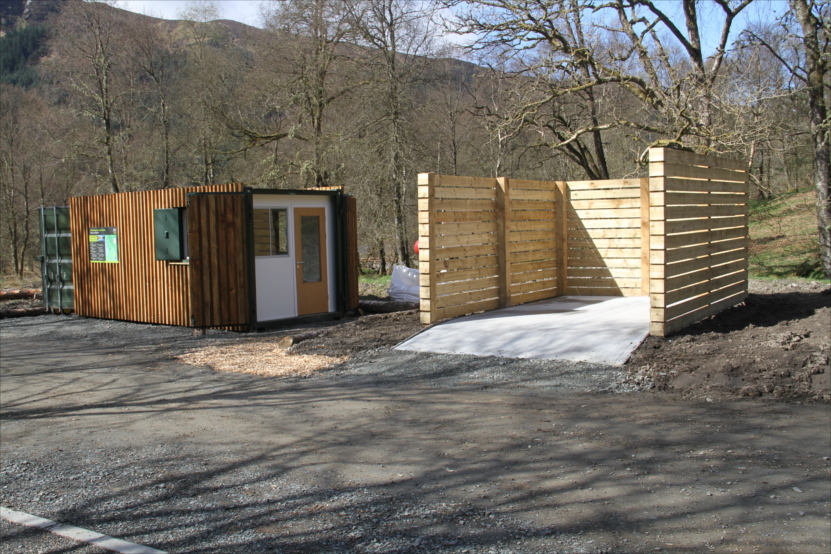
1. The bin store sited at the RHS the Ranger Base and Store does not appear on any of the plans for the site and is therefore a breach of planning consent. In addition as it is such a large structure it should not be considered an Non Material Variation as it has a major impact on the efficacy of the site and it’s rural and natural aspect. It seems almost inconceivable that the final purpose of this structure is a bin store and it appears to the casual onlooker that the National Park authority intends to re-task this structure for another purpose. It should therefore be removed and an investigation into it’s erection should commence as a matter of public concern.
2. The containers used for the Rangers Base and the water purification plant do not correspond with the engineering drawings in respect to the size and finish to the end elevations shown in your documentation.
In both instances the doors fitted are taller than those specified which in turn has prevented fitting a wooden facing above them as specified.
In the case of the Ranger Base Store end the door fitted is larger and of a different design with locking bars on the surface which are totally unsuitable as a solution in this sensitive site.
The wood cladding to the exterior of the containers do not conform to the engineering drawings, the posts and concrete ground supports have not been fitted with the cladding being applied to the container surface directly, this contravenes the design specification and the resultant aspect is an industrial container which has no place in this sensitive area.
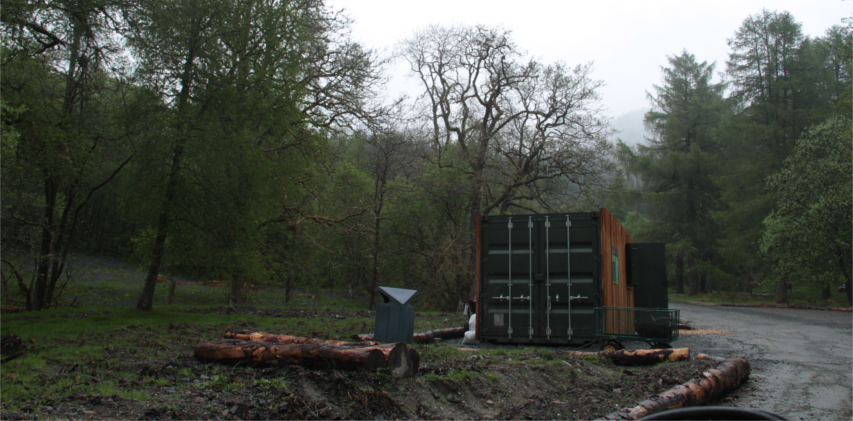
3. The wood cladding to the exterior of the containers does not conform to the engineering drawings, the posts and concrete ground supports have not been fitted and th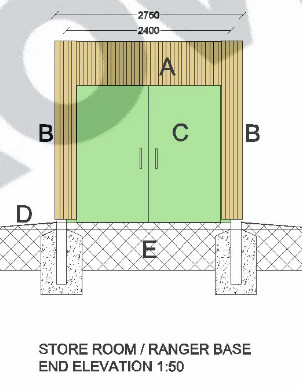 e cladding has instead be applied to the container surface, this contravenes the design specification and the resultant aspect is an industrial container which has no place in this sensitive area.
e cladding has instead be applied to the container surface, this contravenes the design specification and the resultant aspect is an industrial container which has no place in this sensitive area.
The permanent nature that was presented in the original drawings and at the planning consultation meeting have been subverted by removing the concrete embedded posts which suggests the Park Authority as the applicant again have intentionally deceived the planning authority and have an intention to move, remove or in some way alter these structures and have pre-empted that requirement by violating the terms of the planning consent.
This requires investigation. If it is the intention to remove these structures from their position on site and deny access to the public out-with the management season this should have been made clear on the application, in any case the reason for this variation should be established.
It is also strange why the planning authority approved drawings from the applicant which only showed one end elevation, this is highly irregular and also requires explanation.
4. The logs to the side of the Ranger base have prevented proper landscaping of the area underneath and their eventual removal will cause further disruption to the ecosystem, they are an eyesore and should be removed immediately and the area regraded to allow vegetation recovery to continue unhindered.
5. The grading of the ground to provide a low angle rise to the edge of the containers at door entry points has not been carried out at the store, the rangers base and the plant room.
6. The ground works on the site remain unfinished in a number of respects:
a. The seeding of bare soils and restoration works have not been (started ?) completed across the development and the changes at pitches 8 and 9 should have demanded seeding of the soil pitch surface, soil being an unacceptable medium for pitching tents. Path edges, large area adjacent to ranger base and car park surrounds are being left to self seed which is failing and the seeding schedule agreed should be carried out immediately.
Undocumented changes to pitch surfaces comprising aggregate and sand have been created without consent, this sand finish is an abomination, wet or dry, this grit sticks to feet and hands to be carried into the tent causing discomfort and nuisance. It may be possible to mitigate where seeding with grass would bind the sand together and provide the required surface finish.
On walk around, overspill of hardcore at corners and junctions of the road/path network is evident in many locations, nature has overtaken and hidden the less serious instances allowing the applicant to get away without restoring the original vegetation, but there remains many areas of concern that require remedial action. It is not sufficient just to allow the self seeding of natural grasses to eventually mask the building material contamination the planning consent called for proactive restoration using reserved material and seeding and a general level of care to ensure building materials did not contaminate the site. This requirement has just not been met.
Of course the stated reseeding schedule in the planning application is not without risk and I would expect the planning department and the applicant are well aware that the colour and nature of the recommended seed mix for restoration will not match the natural vegetation in this area perhaps exacerbating the problem. This of course is why the retention of the vegetation removed from paths and other works were so important to the successful restoration of this project and the failure of the planning department to ensure that was done has left ecological damage that may never return to it’s original state. The applicant should take stock of the environmental damage they have caused.
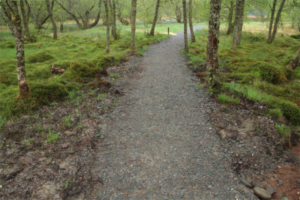
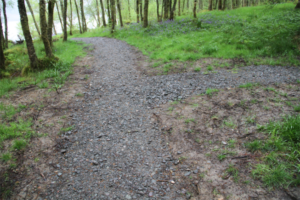
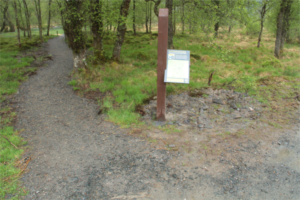
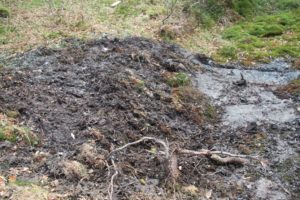
On the Path leading to pitch one, there has been no attempt to clear away the hardcore contamination of the surrounding vegetation and no seeding has taken place. No restoration of vegetation along many areas of path and the 4th image shows a failed attempt to remove a hardcore pile dumped on vegetation where a succession of attempts using machines for removal have made matters worse.
 Bridge
Bridge
The bridge solution is a mess. Hardcore is falling into the stream through very poor containment. The expansion of the path at the junction to an unacceptable width with hardcore marring the natural ground and vegetation cover without attempted restoration.
The protruding pipe of the culvert should have a natural stone surround wall in a development such as this. The solution provided is not suitable for a flagship development in a National Park where even a pub in Tyndrum can provide a stone faced wall to a piped culvert.
The nature of this slope down to the river is an unnecessary hazard, it would be far better with a retaining wall and a vertical drop to the river where danger is apparent, this solution it invites children to play on what is effectively a scree slope and once a slip begins the outcome is inevitable.
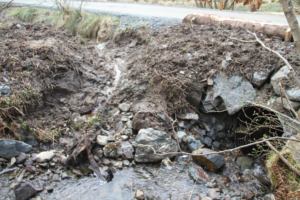 Attempts at restoring vegetation over this hardcore has been made since this image was taken it is a piecemeal approach an as can be seen from the other side, where no attempt has been made to grade in the edges of the road and vegetation as required and no seeding.
Attempts at restoring vegetation over this hardcore has been made since this image was taken it is a piecemeal approach an as can be seen from the other side, where no attempt has been made to grade in the edges of the road and vegetation as required and no seeding.
The other side of the bridge has similar issues with attempted soil and vegetation replacement, how successful this will be, depends on the on going availability of water to the root system which may be an issue in dry weather. Monitoring of this area should continue to ensure the applicant provides a suitable long term solution should this restoration attempt fail.
Restoration to damage caused by relocation of pitches
Restoration works to areas damaged by LLTNPA through agreed and non agreed changes

have not been completed using the vegetation that should have been retained for such purposes. Paths and pitches positioned wrongly and subsequently removed have not been restored to their former condition.
Pitch 10, the original stub path has been removed and not restored leaving this water filled hole contaminated with hardcore.
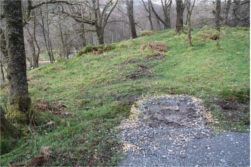 Pitch 12 the original stub path has been removed and not restored leaving a hole and some hardcore in the environment.
Pitch 12 the original stub path has been removed and not restored leaving a hole and some hardcore in the environment.
d. Areas of cross contamination where building materials have been dumped in the environment and left exposed, e.g. just uphill from the bridge on the toilet block side, these materials should never have been left on site and should be removed prior to proper restoration and seeding.
e. The use of grit (course sand consistency) as a pitch surface over quartz pebble was never and should not have been agreed, it’s an abomination in a campsite and has been used by the applicant to hide material problems. It has been deposited over peat/moss wet areas, steep slopes and bramble patches to mask the underlying issues Pitches 6, 14, 15 and 19 are affected and the resultant mess in the ecosystem is unacceptable environmental destruction and a horrible visitor experience as a paid for pitch surface which in all cases should be grass..


f. The finish to the roads is abysmal, and it would appear they do not conform to what is detailed in the original specification, there is an expectation another material would provide the final finish over the hardcore base. It is also reasonable to expect a new road would not be pot holed and have 1” to 4″ hardcore strewn over the road way and spreading on to the grass verges. There has been no attempt to restore the exploratory hole dug down to the water pipe which can be seen just above centre on the RHS image.
g. The slope between the bridge and the water purification building has had sand/grit, used for pitch surfaces and path infill dumped to the side of the road together with other materials.
The extraneous building material appear in a number of locations on site and it is clear the applicant is just waiting for nature to grow over them instead of removing them as per terms of the planning consent to prevent cross contamination in a sensitive area. This contamination should never have taken place if the Ecological Clerk of Works had been present to monitor the work.
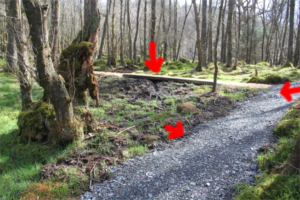
6. The documentation from SEPA which has been removed from the idox system for public viewing stated that the paths between the road and pitch one should be flush with the surrounding terrain the paths created by LLTNPA are not flush in all places, where hardcore has been laid on top on the existing vegetation with and without a membrane, this is in breach of the planning consent and the recommendations from SEPA regarding interference with drainage of the flood plain. I would think it is also highly undesirable to use woodchips, a floating material, in a flood plain.
7. Transverse Paths created on the hill side are floating in wet weather having been laid over peat or moss substrate, these paths should have been dug out at the affected areas and consolidated to provide a firm surface. The arrows show position on this image, at the other corner of the path where it turns down hill the same spongy surface exists. The top section of the path loop at pitch 18, 19 and 20 swinging back down towards pitch 17 is affected in places.
The central arrow in this image shows a channel created by the appicant in peat. This should be in filled to stop a new water course being created. The Applicant has destroyed the moss ecosystem in a large triangle from the bridge to the tree in the foreground and failed to restore the surface leaving grasses to encroach on what should be moss. The eco system here has been irreversibly destroyed.
Going further along this transverse path it is clear the path has interfered with the flow of water down the slope the ground immediately uphill from the path is wetter and in rainy weather fills with water which eventually overflows the barrier formed by the path crossing it in a number of locations.
There is also a spongy area on the path just down hill from the corner that according to planning consent should be corrected. The path where it turns back downhill is particularly affected, water crosses the path and flows down it’s side until it finds an easier route down into pitch 17 where it maintains the permanent wet aspect of this pitch. (see appendix A) Even before the path was created the location of pitch 17 was fed from the water coming downhill in a natural water course, the path has merely created a second route for water delivery.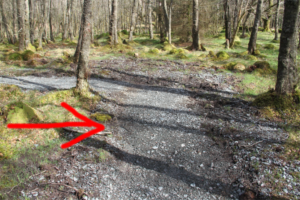
This image also demonstrates the cross contamination of hardcore onto the surrounding ecology.
8. Many of the pitches remain poor quality, and while a few will respond to continuous hard strimming they are still hampered by a poor site on slopes. Others have flaws which are caused by their positions in water courses [10, 17], or beside standing water [26] and/or dense vegetation . The light touch proposed by the applicant is a nonsense and no more than an excuse for doing little or nothing. These plants affecting pitches are voracious and require severe methods of control where brambles will grow 3 inches in a day it is obvious that removal is the only real option, the park have not chosen to to go down that route and have tried instead to cover over with sand and aggregate.
The last problem with the site is the size of pitches, The applicants own research shows demand for camping is predominantly from families requiring pitches to handle family sized tents and area around the tent to allow occupants to relax, sit and cook in the area with a fire-pan a safe distance from the tent the pitch size at this site does not reflect the demand
The planning department have failed to regulate the design of these pitches allowing the applicant to place a dot on a map clearly without first surveying the land properly resulting in the majority of pitches being created on sloping sites, small constrained areas, water logged sites and sites of dense vegetation including brambles. This failure is responsible for the large number of pitch problems at this development but more importantly it has allowed the applicant to mislead the public and stakeholders that this hillside location was suitable for creating camping provision in the first place.
The selection of slopes for pitches is not acceptable above a few degrees as anyone sleeping on a mat will side down the slope, the small size of pitches makes it impossible to fit a tent in some cases never mind align the tent to the slope, effectively making the pitch unusable. There are also other considerations when camping that are impacted by pitch size, in poor weather the longitudinal axis of the tent should be aligned with wind direction and the door placed to the lea side, this is not possible to accomplish on a small oblong pitch and is important in exposed sites such as Loch Chon.
Because proper confirmation of each pitch layout was not sought by the planning department, the Park Authority have sized pitches based on the footprint of a tent and failed to consider that a tent requires approximately 4 times that area to accommodate guy lines alone and then an absolute minimum of 4 times that combined area again to accommodate the occupants and the area for cooking, seating, relaxing and a fire pan at a safe distance from the tent.
At the public planing meetings to discuss the nature of the site the applicant misled the public into believing this site would be in the same class as Sallocy. The nature of the site could never support this comparison as the original pitches on the shore of Loch Chon were specifically excluded so the site could support day visitors on the shore locations. On March 1st 2017, the only pitch on the entire site that is acceptable without any issues was pitch 21 on a shore location which pre existed the development. The applicants fantasy that suitable pitch surfaces would be achieved by simply “scraping” the area has been born out as unachievable. Any attempts to scrape out with the intention to level a slope would result a water sump and so it never was a reasonable solution but one that was pursued to overcome objections at the planning stage.
a. Many of these ancient and natural woods on the west coast of Scotland are technically temperate rain forests due to the high rainfall, While previous developments at Loch Chon have disturbed the nature of the site it still did not and does not lend it’self for campsite conversion on the scale implemented, more than 3 times larger than the site previously handled.
It is clear that the popular areas of the park previously used, have been selected by park users on the basis of their suitability for camping, flat, level, grass covered and loch side locals usually on fluvial plains which are on the whole drier than the surrounding wooded areas. The applicants decision to exclude the existing loch side pitches from camping (except pitch 21) presumably to maintain an area for day visitors to use, and then exclude day visitors from parking by changing the agreed consent is a travesty leaving 8 – 10 pitches on site that are basically unusable and another number not up to the stated “Internationally-renowned National Park Experience”
b. Further, as you should now be aware, pitches cannot be created in a single season and together these are the primary failures in understanding camping in the park. Good sites are created by nature and found by campers and then naturalised over time by constant use in popular loch shore locations, nothing less will do. As far as forest locations are concerned they are few and far between where rainforest and commercial forests do not provide viable camping as a rule.
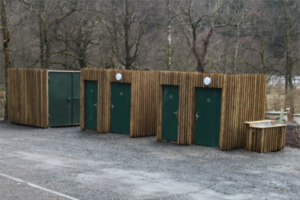
9. The lighting bulkheads do not comply with the dark skies initiative I would have thought that would have been a prerequisite for all lighting in the park but more especially in a location away from other light contamination where the benefits of such fittings would make a real difference.
The lighting has been recessed into the wood cladding since this image was taken but that has no material effect on light pollution of the sky and hillside opposite.
10. The Toilet block water supply has not been fully operational since the site opened on the 1st March 2017 on the very small number of days the site had toilets and wash hand basins operating at the same time as the drinking water supply were hampered by very low pressure where even the timed shut off on the drinking water taps would not activate.
The applicants camping booking system states the site has no drinking water, although currently
the drinking water for this site is supplied via 330ml plastic bottles  issued free to park users. This is unacceptable and so far the applicant has failed to explain why they are not taking steps to correct the error with the water intake pipe and reposition it further upstream with a suitable reservoir. Their are also reports that sparkling water has been supplied in error.
issued free to park users. This is unacceptable and so far the applicant has failed to explain why they are not taking steps to correct the error with the water intake pipe and reposition it further upstream with a suitable reservoir. Their are also reports that sparkling water has been supplied in error.
This is a very serious breach in planning consent and raises a lot of of other issues of health and safety where the water supply is so tenuous. Effective dish washing cannot take place in the trough provided using 330 ml bottles of water.
Intake Port.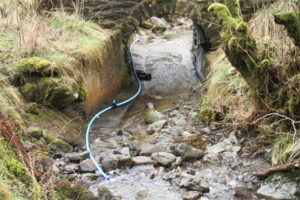
The original drawings which you have removed from your system showed the water intake upstream from it’s current location as shown here, it is clear that this was the intended position due to pipe clips and small rock built dam.
Due to a failure of the planning department to insist on construction drawings detailing the construction of the necessary reservoir or header tank, or the selection of a suitable natural alternative, to guarantee a sufficient head of water to operate the system, the applicant was not constrained. Their contractor fitted the intake pipe, in good faith, at a location that was later to prove unsuitable as the water level in the stream dropped in dry weather leaving the intake above the water level. This was however the location agreed in the planning consent and it would seem no proper evaluation or calculations of the technical requirements for the intake were carried out to support this location, not least the need to be underwater.

The diagram illustrates the issue
The Park Authority then went ahead and made further changes without consent or informing the planning authority it would seem, as the absence of documents in the idox system suggests.
The new location for the intake port is under the cul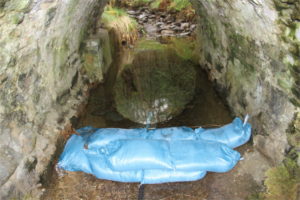 vert, I would think a wholly unsuitable location due to it interfering with the requirement to have a smooth unimpeded surface in the culvert to stop build up of debris.
vert, I would think a wholly unsuitable location due to it interfering with the requirement to have a smooth unimpeded surface in the culvert to stop build up of debris.
The resultant head of water has been reduced by a meter or so exacerbating the situation where this reservoir needs to be placed upstream to increase water pressure.
The interference of water flow in a culvert is also undesirable and is surly a matter for SEPA where the inevitable build up of debris behind the dam will cause problems.
The moving of the intake pipe downhill is in breach of planning consents as an NMV would not be adequate to cover a change requiring calculations and of water heads and pressures at the output of the sterilisation system.
Of course there is the complication of the inspection chamber and tank close to the Ranger base and questions to whether or not that is a sealed chamber, The uses of the pump that was reportedly retrofitted should have overcome any head issues but seemingly has not. It’s time the applicant made the issues public and gave timescales for reparations.
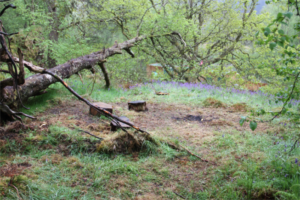
11. Other structures are appearing on site, this one in the form of communal seating area close to pitch
12. this areas look to be constructed by Park Rangers and are a contravention of the planning consent.
Pitch 12 on the other hand is so small there is no space for a family tent and seating in the same area. It’s concerning with one of the main justifications for creating management zones being fire rings that the Park Authority are permitting fires in the eco system.
That is not to say that a communal seating area is not desirable, in a properly planned camping site. This provision should be a feature at every pitch and that is certainly true of the pitches here at Loch Chon where many have no room for occupants or even seating and cooking nearby.
That said, it should have been the subject of proper planning consent. The Park Authority obviously believe planning requirements do not apply to their projects and proceed to do what ever they wish without challenge. Pitches 8, 9, 10, 12 14, 15 are modified and/or relocated and for the most part to small to contain tents and occupants comfortably for their intended use, 8 and 9 being disabled pitches.
The use of woodchips was the subject of much concern and we can now see it being carried by feet from the paths across the pitch sites and the ecosystem beyond. The rediculous “postage stamp” bark paths to pitches 4, 5, 12 and others serve no purpose and should be removed.
That is a summary of the problems and issues at this site.
A number of pitch issues were included in the original communication. These have not been reproduced here.
What I require to happen to resolve my complaint.
The Planning Authority should take up and enforcement position and ensure the applicant complies with the original planning consent in all respects. Particularly with a view to removing structures, especially the bin store, and others that do not form part of the original planning consent and restoration of the ecosystem to it’s original state.
The Planning Department should investigate and explain how with all the checks and balances alluded to in the planning application including oversight of an environmental Clerk of Works, that this poor outcome and environmental damage was permitted to continue without feedback, and agreements from the Clerk of Works were not a feature of the development as was clearly stated as a requirement in the consents.
They should also explain and/or investigate the following:
1. Removal of parking spaces after the agreed consent and public debate.
2. Failure to visit the site and enforce the contraventions from planning consent.
3. Failure to insist on a hydrology report for the stream.
4. Failure to insist the applicant provided detailed drawings with all elevations for the containers and in particular the details of the position and nature of the the water intake including calculations of water pressure achievable.
5. Failure to insist on details of pitch locations, slope, vegetation and size suitable to take tents their occupants and equipment, this after all being the primary purpose of the development.
6. Failure to monitor the progress on site at a stage where intervention would have prevented many of the issues we now have at the end of the project.
7. Failure to monitor the storage of restoration vegetation and the reinstatement of the site.
8. Failure to enforce breaches in planning consent where the Applicant is LLTNPA.
The Planning department have consented to a 26 pitch camping site a Loch Chon and the applicant has not delivered 26 pitches that are viable for camping upon.
The planning department should enforce the provision of 26 viable pitches together with the necessary drinking water supply as a mater of urgency as we are entering the peak season and paying customers have no dish washing facilities and drinking water from 330 ml bottles. The Park Authority has stated on their booking system that drinking water is not available and that in itself that should precipitate closure of the site.
A report on tree removal and damage cannot be carried out at this time as the tree protection plan has been removed from the idox system.
The planning authority should immediately reverse it’s decision to hide documentation on the idox system preventing public scrutiny of LLTNPA projects so hiding any failure to concur with it’s planning consents. The agreement of consent is only the start of the project not the end these inconsistances seem to favour Park Authority Projects.
Further the planning department should identify the creation date of documents so clarity of the audit trail can be established and monitored and documents should have this information in their meta data. The use of a “date posted” is it would seem the date the documents are made visible to the public it is meaningless in the audit trail as the documents are retrospectively uploaded.
All of these anomalies present a ethical problems in the planning system where the true nature of dates and documentary evidence of the planning procedure are being intentionally obfuscated.
This is a breach of your own standards of openness and transparency and it precipitates the question why are documents relating to LLTNPA hidden when it is of great public interest to ensure there is a viable and demonstrable separation between the applicant and the planning authority. This is clearly not the case where the applicant is Loch Lomond and the Trossachs National Park.
Thanking You
Yours faithfully
